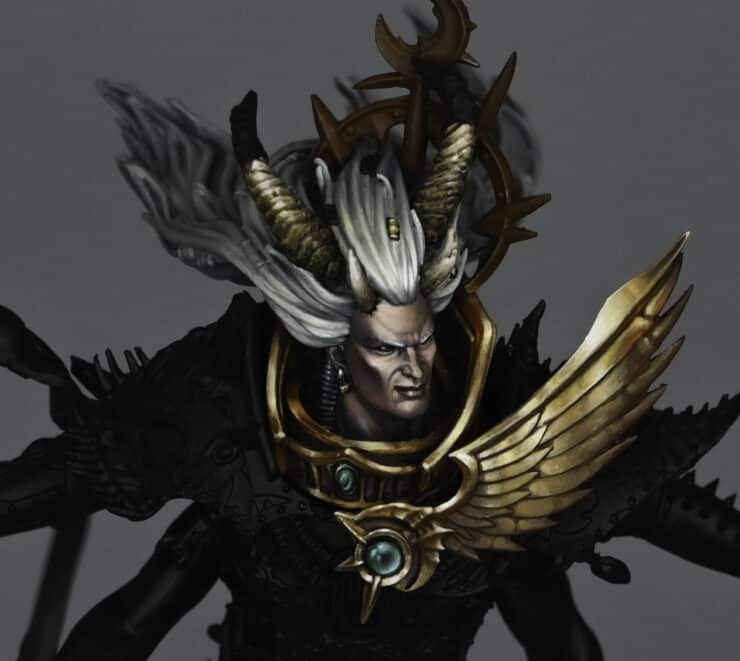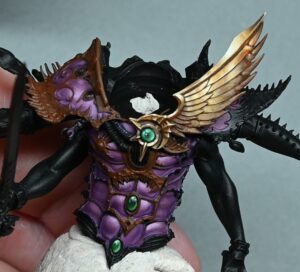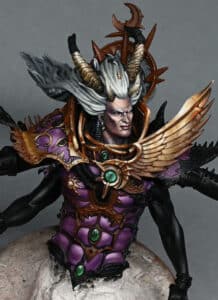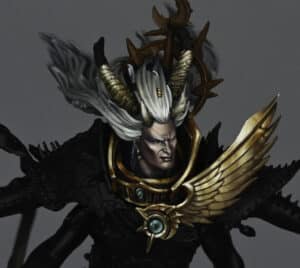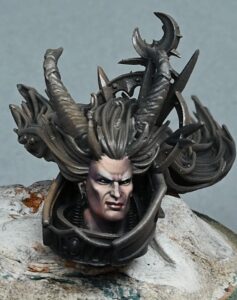Two more videos for Fulgrim, this time how to paint the NMM (non-metallic metal) on his chest, plus the gem, too.
Gold Wing NMM
This video shows you how to paint the Non-Metallic-Metal Gold on the chest of Fulgrim. It talks about the reflections and some of the difficulties with the shape of the piece.
The following paints were used:
Games Workshop: Rhinox Hide, Mournfang Brown, XV-88, Balor Brown, Troll Slayer Orange
Vallejo: Ice Yellow
P3: Morrow White
Kimera Colours: Diarylide Yellow (Fire Dragon Bright alternative)
Quick Fulgrim NMM Tips:
Colour Mixes for Base Coat: Use a mix of colours for the base coat; in this case, Mournfang Brown was used. Experiment with mixing to achieve the desired tone and richness.
Layering for Opacity: Layer the colours with attention to opacity. Ensure that each layer is opaque enough, especially for brighter colours like Ice Yellow, to maintain a shiny and clean appearance.
Brush Selection and Size: Choose a brush size appropriate for the area being painted. Larger brushes can cover larger surfaces efficiently, while smaller brushes are useful for detailed work and additional reflections.
Highlights and Shadows: Gradually build up highlights, paying attention to where the light hits the most. Add shadows with darker tones, keeping in mind the overall light direction.
Reflections and Light Volumes: Consider reflections on the model, especially on curved surfaces like wings. Mimic light volumes to create a realistic appearance. Don’t forget smaller reflections to add complexity.
Patience with Resin Models: Be patient when working with resin models. Expect the need for additional tweaking and cleaning during the painting process due to the material’s characteristics.
Scale Realism: Adjust the scale of details to the model’s size. For larger models like Fulgrim, make smaller details extra tiny to maintain a realistic appearance.
Focal Points: Invest extra time and attention on focal points of the model, like the wing and face. Perfecting these areas allows for some flexibility in other, less prominent parts.
Balance Brightness: Maintain a balance in brightness across different sections. Avoid making some areas too bright, as it can affect the overall realism of the NMM effect.
Green, Shiny Gem
This video shows you how to paint the green, shiny gem on the chest of Fulgrim. It talks about the reflections and some of the difficulties with the shape of the piece.
The following paints were used:
Games Workshop: Sotek Green, Moot Green
Vallejo: Black (only to correct mistakes)
P3: Morrow White
Top Gem Tips:
Colour Consistency is Key: When painting gems, mix your own colours to maintain consistency throughout. Experiment with different shades, but ensure a harmonious look by using variations of the base colour
Define the Shape: Gems with protruding shapes require more definition. Paint a circle around the gem to give it a three-dimensional appearance. Be mindful of how light interacts with the shape, especially from different angles.
Play with Reflections: Instead of the standard dark top left, light bottom right approach, add three distinct reflections for a more unique look. These reflections can be influenced by the gem’s surroundings, offering a chance to get creative with the environment’s impact on the gem’s appearance.
Distortion Matters: Consider the shape of the gem when painting reflections. A sphere, for example, will distort reflections, so adjust accordingly. This adds realism and interest to the gem’s appearance.
Adjust Saturation for Impact: After painting, use glazing to adjust saturation, especially at the edges of highlights. This technique can bring out a stronger colour without compromising the contrast. Remember to leave the black section undisturbed for high contrast and to make shine spots stand out.
Experiment with Gem Cuts: Don’t feel limited by traditional gem-cut rules. Different gem cuts can impact reflections, so if your gem has a unique shape, consider how it interacts with light and reflections.
Incorporate Environmental Factors: Gems don’t exist in isolation. Consider the environment of your model and how it influences reflections. Objects nearby, lighting conditions, and even occlusions or inclusions within the gem can affect the way light plays on its surface.
Details Matter: Pay attention to small details. Even if a flaw is present in the resin mould, take the time to correct and refine it. Small adjustments can significantly enhance the overall appearance of the gem.
Experiment with Colour Palette: While my tutorial suggests specific colours, don’t hesitate to experiment with your own palette. Gems come in various colours, and adapting the technique to different hues can yield exciting and unique results.
Have Fun and Be Creative: Painting gems offers an opportunity for creativity. Don’t feel constrained by conventions. Have fun experimenting with colours, shapes, and reflections to create a gem that stands out and adds character to your model.
If you don’t have an account, please sign up here! The website currently has over 350 video tutorials, plus step by step guides and PDFs. You can explore more free videos with a free “freebies” membership, or take the plunge and become a full subscriber for full access.
If you’d prefer to support me on Patreon, please visit: https://www.patreon.com/RichardGray





